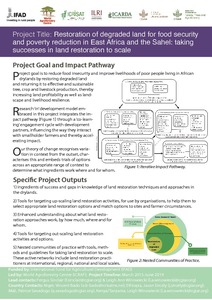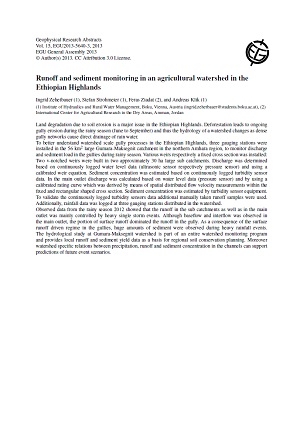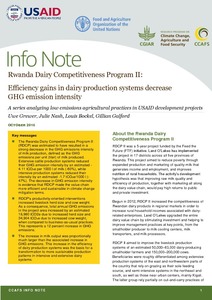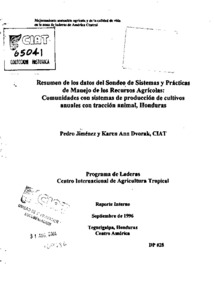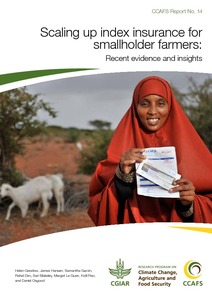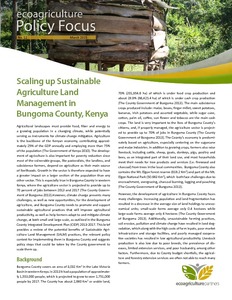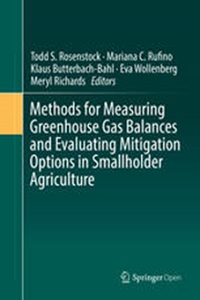Review of climate service needs and opportunities in Rwanda
Rwanda’s variable and changing climate is an increasingly serious challenge to the country’s
agricultural sector and farming population. Climate information services are emerging as a
means to support farmers to manage risk and provide an opportunity to build the resilience of
agriculture to climate at all time scales. Climate services include historical, monitored and
forecast information, and value-added information products such pest and disease risk
warnings, crop yield forecasts, or management advisories. The new Rwanda Climate Services
Runoff and sediment monitoring in an agricultural watershed in the Ethiopian Highlands
Land degradation due to soil erosion is a major issue in the Ethiopian Highlands. Deforestation leads to ongoing gully erosion during the rainy season (June to September) and thus the hydrology of a watershed changes as dense gully networks cause direct drainage of rain water. To better understand watershed scale gully processes in the Ethiopian Highlands, three gauging stations were installed in the 56 km2 large Gumara-Maksegnit catchment in the northern Amhara region, to monitor discharge and sediment load in the gullies during rainy season.
Rwanda Dairy Competitiveness Program II: Efficiency gains in dairy production systems decrease GHG emission intensity
? The Rwanda Dairy Competitiveness Program II
(RDCP) was estimated to have resulted in a
strong decrease in the GHG emissions intensity
of milk production, defined as the GHG
emissions per unit (liter) of milk produced.
Extensive cattle production systems reduced
their GHG emission intensity by an estimated -
4.11 tCO2e per 1000 l of milk (-60%), while
intensive production systems reduced their
intensity by an estimated -1.7 tCO2e/1000 l (-
47%). The decrease in GHG emission intensity
Resumen de los datos del sondeo de sistemas y prácticas de manejo de los recursos agrícolas : Comunidades con sistemas de producción de cultivos anuales con tracción animal, Honduras: Reporte interno
Review of CGIAR Research Programs Governance and Management: Final Report
The Review of CGIAR Research Program Governance and Management was requested by the CGIAR Consortium and
approved by the Fund Council in November 2012. The Independent Evaluation Arrangement (IEA) is responsible for the review, which was carried out between June 2013 and January 2014. At the time the review was initiated, Consortium Research Programs (CRP) governance and management structures were in place or approved for each CRP. This enabled
Scaling up index insurance for smallholder farmers: Recent evidence and insights
This report explores evidence and insights from five case studies that have made significant recent progress in addressing the challenge of insuring poor smallholder farmers and pastoralists in the developing world. In India, national index insurance programmes have reached over 30 million farmers through a mandatory link with agricultural credit and strong government support. In East Africa (Kenya, Rwanda and Tanzania), the Agriculture and Climate Risk Enterprise (ACRE) has recently scaled to reach nearly 200,000 farmers, bundling index insurance with agricultural credit and farm inputs.
Scaling up Sustainable Agriculture Land Management in Bungoma County, Kenya
Agricultural landscapes must provide food, fiber and energy to
a growing population in a changing climate, while potentially
serving as instruments for climate change mitigation. Agriculture
is the backbone of the Kenyan economy, contributing approximately
25% of the GDP annually and employing more than 75%
of the population (The Government of Kenya 2010). The development
of agriculture is also important for poverty reduction since
most of the vulnerable groups, like pastoralists, the landless, and
Seasonal response of grasslands to climate change on the Tibetan plateau
Shortening of the growing season despite a longer thermally favorable period implies that vegetation on the Tibetan Plateau is unable to exploit additional thermal resources availed by climate change. Ecosystem composition may no longer be well attuned to the local temperature regime, which has changed rapidly over the past three decades. This apparent lag of the vegetation assemblage behind changes in climate should be taken into account when projecting the impacts of climate change on ecosystem processes.
Safe wastewater reuse: a call for sanitation safety plans.
The publication of the third edition of the WHO Guidelines for Drinkingwater Quality (WHO, 2004) introduced the concept of integrated, preventive risk management through water safety plans (WSPs) as a means to put into operation the principles, standards, norms and best practice proposed by the Guidelines. The WHO suggests applying the same concept to support the implementation and operationalization of their Guidelines for the Safe Use of Wastewater, Excreta and Greywater in Agriculture and Aquaculture (WHO, 2006) which follow the same principles of HACCP and health-based targets.
Secondary forests in swidden agriculture inthe highlands of Thailand
Swidden farming is the main agent of conversion of primary forests to secondary forests in the highlands of mainland Southeast Asia, but there is a deterioration and decline of the practice with land use intensification. The population growth in northern Thailand has forced lowland farmers practising permanent wet rice cultivation to turn to short rotation swidden in the foot hill zone. Highland swidden agriculturists are adopting more intensive forms of swidden or are shifting to permanent farming.
Scaling point and plot measurements of greenhouse gas fluxes, balances, and intensities to whole farms and landscapes
Measurements of nutrient stocks and greenhouse gas (GHG) fluxes are typically collected at very local scales (<1 to 30 m2) and then extrapolated to estimate impacts at larger spatial extents (farms, landscapes, or even countries). Translating point measurements to higher levels of aggregation is called scaling. Scaling fundamentally involves conversion of data through integration or interpolation and/or simplifying or nesting models. Model and data manipulation techniques to scale estimates are referred to as scaling methods.

